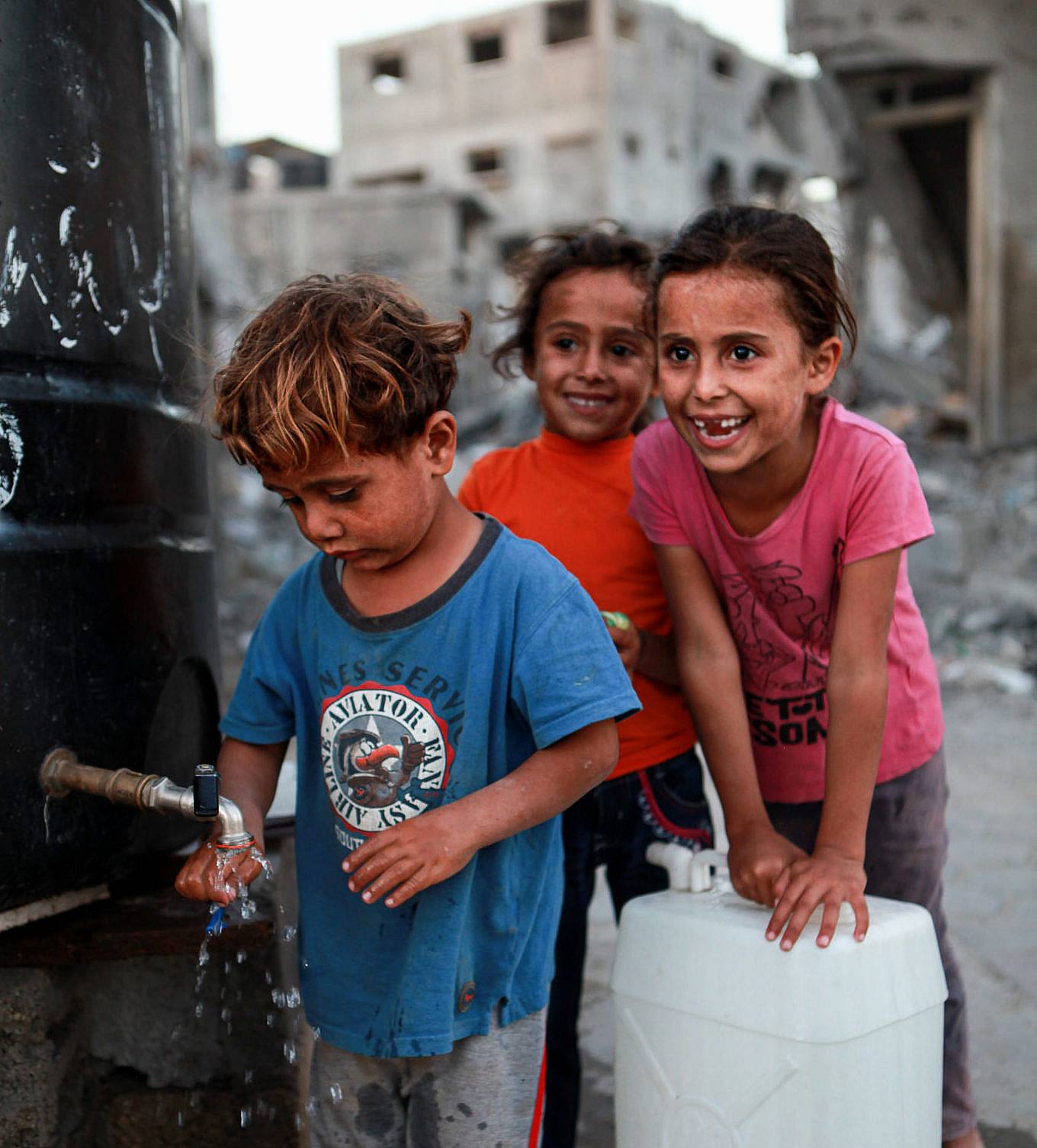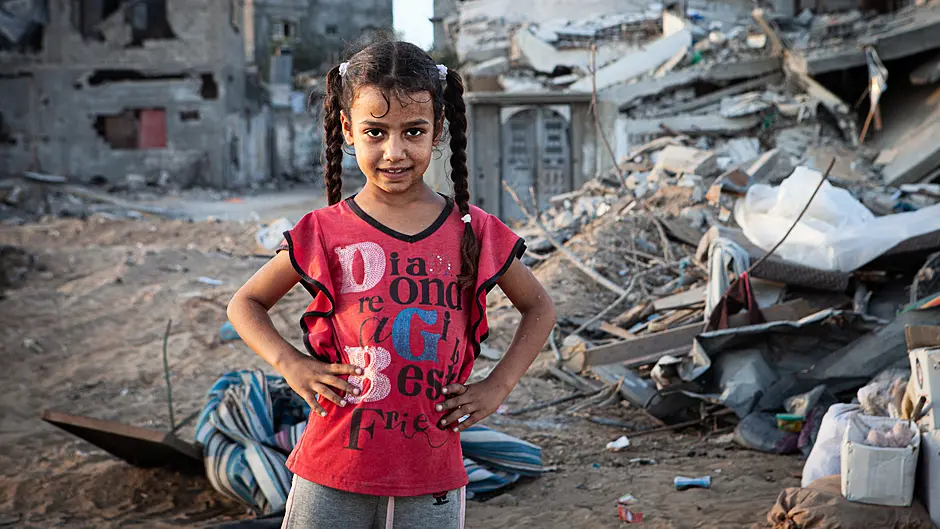In 2014 Cork photographer and cameraman ED GODSELL travelled to Gaza to document life in the aftermath of an Israeli ground assault. What’s happening this year, almost a decade later, has prompted him to reflect on that visit, as he wonders how the people he met then are faring now
IT was this month nine years ago that I went to Gaza following the last Israeli ground assault on Gaza known as ‘Operation Protective Edge’ in 2014.
I had recently finished a course taught by American military medics in Kosovo that was training freelance media personnel who work in conflict zones how to apply emergency first aid. I met many young freelancers from all over the world on that course, working in the many conflict zones at the time. War was raging in Syria, Libya, Afghanistan, Gaza and the conflict was beginning in the Donbas region of Ukraine.
 Palestinian children smile as they collect water from a makeshift water tank in Gaza in 2014. (Photo: Ed Godsell)
Palestinian children smile as they collect water from a makeshift water tank in Gaza in 2014. (Photo: Ed Godsell)
It struck me that a documentary on the lives of these freelancers would make for fascinating viewing. Their working lives can be extremely intense, rewarding and also damaging but they provide an invaluable source of information as to what is happening on the ground. I pitched the idea to a reputable US production company who had made similar kind of films and they responded positively. They asked me to make what in the industry is called a ‘teaser’ – a scene that they could use to sell the film.
One of the freelancers that I knew was an Italian working in Iraq and there was also a young Slovenian photographer in Gaza covering the aftermath of the IDF ground assault, but the timing worked better for Gaza. It’s not easy as a journalist to get into Gaza. You need permission from the Israeli side, and they are very careful about who they let in. All kinds of documents are needed and a letter of intent from your employer. I asked the film company for this letter and the day before I was due to fly I received a bitterly disappointing email from them, informing me that they had changed their minds on the project – they thought it was too risky.
They had worked with an English freelancer, Tim Hetherington, who was killed whilst working in Libya and they decided they didn’t want to risk being associated with another potential casualty. I decided to go anyway and would try and pitch the idea to another company on my return. I planned to stay in Gaza for seven days but it took nearly two weeks wait in Jerusalem before I was finally was approved for an interview with Israeli foreign affairs office.
Those three weeks proved to be one of the most memorable few weeks in my career.
 Ed Godsell, left, with documentary maker Matic Zorman in Gaza in 2014, and a young boy holding the Palestinian flag.
Ed Godsell, left, with documentary maker Matic Zorman in Gaza in 2014, and a young boy holding the Palestinian flag.
Due to its history and importance for the three major world religions, Jerusalem is a heady place, to say the least. But the day I arrived it happened to be, by pure coincidence, a religious holiday for both Jews and Muslims and so the city was buzzing with energy and also tense, due to the recent war in Gaza.
My first trip to the Holy Land re-enforced my belief in the dangers of any religious fundamentalism.
Of course, there are admirable qualities in each of the three great religions which claim unbreakable bonds with Jerusalem but what I witnessed in my week in Jerusalem I couldn’t in any way describe as ‘holy’!
I shared a hostel with a group of Christian fundamentalists who tried to convince me of the coming apocalypse. In their eyes, Armageddon was not only unavoidable, being ‘pre-ordained’ as part of God’s plan, but desirable, too. I met a cheerful Palestinian Arab tea seller who seemed extremely happy to meet an Irishman and proudly exclaimed his support for the IRA, before attempting to convince me that the Jewish Holocaust during WW2 was just a big lie.
In the Jewish quarter of the old city, overlooking the revered (by Muslims) Al Asqa mosque where once stood the holiest of Jewish temples before being destroyed by the Romans, there was encased in re-enforced glass a huge Jewish Menorah (candelabra). Religious Jews were praying beside it and when they had finished I asked one of them what he was praying for. He told me that he was praying that soon the menorah would be moved into the third temple, which was to be built on the ruins of the Mosque across the way. I asked him if the destruction of the mosque that is so revered by the Islamic world would lead to war and his reply, chillingly, was that it more than likely would, but that that was simply ‘God’s will’.
My interview with the Israeli press office went well. When asked my opinion on the situation, I replied simply that it was tragic for both sides. I was surprised to be given the visa so easily when I knew of other, far more experienced journalists who had been refused. I took a taxi to the border crossing.
 A young boy peers from inside a car with the message ‘I love you’ emblazoned on the window. (Photo: Ed Godsell)
A young boy peers from inside a car with the message ‘I love you’ emblazoned on the window. (Photo: Ed Godsell)
The process of crossing into Gaza is a very surreal experience. You enter a large, hanger-like building. You don’t see the Israeli guards, you just hear them through speakers as they issue instructions. Machines scan you and guards look down at you from a small window high above. You are then held in a ‘holding pen’ and wait in the heat until you are moved forwards and enter a kilometre-long corridor towards a large metal gate which opens to reveal an entirely different world.
Instead of high tech computers and border guards looking down from above, the Palestinian border guards sit in an old portacabin, the rubble of the building that used to be their border post lying all around. I was offered tea and there were smiles all around when they saw the Irish passport.
A taxi took me to the place where I was to stay for the next seven days, with a family that the Slovenian subject for my documentary was staying with. It was only a few kilometres of a ride but I quickly lost count of the destroyed buildings – almost every building was destroyed or damaged.
I put my bags down in the room I was to stay for the week, the outer wall of which was missing due to a rocket strike during the war. The gaping hole was simply covered with a blanket.
I spent the next week filming the photojournalist as he worked. One story was about a kindergarten that had been destroyed, another about a man who had lost both legs and his family were trying to get him out to have surgery, they had twice failed to smuggle him out through tunnels into Egypt.
The stories were harrowing.
I met a family that had been sleeping in a tent for months with their severely mentally disabled son, who was chained to a metal pole because of his constant attempts to run away. Kids were digging through the rubble of their homes looking for belongings, all with the same exhausted expressions. Yet they somehow managed to smile when they saw me and my camera.
I now wonder what has happened to all those kids, and if they have survived this latest brutal conflict.
It is such a horrific spiral of violence and sadly the next generation of militants are probably being seeded with this catastrophic and much larger IDF assault. One evening we went to a Hamas rally in the neighbourhood. They had erected a large outdoor cinema screen where they were projecting videos of the fighters that had been killed or ‘martyred’ in the operation. The more popular the family of the man killed, the more shots got fired into the sky.
A Hamas leader gave a speech which roused the crowd and I was nervous to observe the flashing red light of what must have been an Israeli drone above us. I nervously took note not to stand too close to the podium and avoided shaking his hand afterwards when he did the rounds. Men wearing balaclavas eyed us suspiciously, watching our every move.
The head of the family I was staying with was no friend of Hamas and had no fear in expressing it. He had three sons and no desire to see any of them martyred. He explained how their lives were affected by not joining up, they lose out on jobs and contracts and face social exclusion. He was planning to get all of his sons out of Gaza eventually to get them to Canada where he had a daughter working as a computer engineer.
‘I hold little hope for the future of Gaza,’ he told me.
On the last night we went to visit some Bedouin farmers that kept sheep near the border fence. We met them as they were making tea around a campfire in the middle of the ruins of what was left of their farms. Sheds had been flattened by the tanks that passed through and there were still the carcasses of sheep that had been squashed under their tracks. We could see the lights of Tel Aviv in the distance.
It was Friday evening and the lights of the busy bars were flashing out into the night sky.
One old man remarked that as Bedouin they had been born under the stars with nothing and that they would die under the stars, that there was nothing the Israelis could take from them – as long as the stars still shone above.










